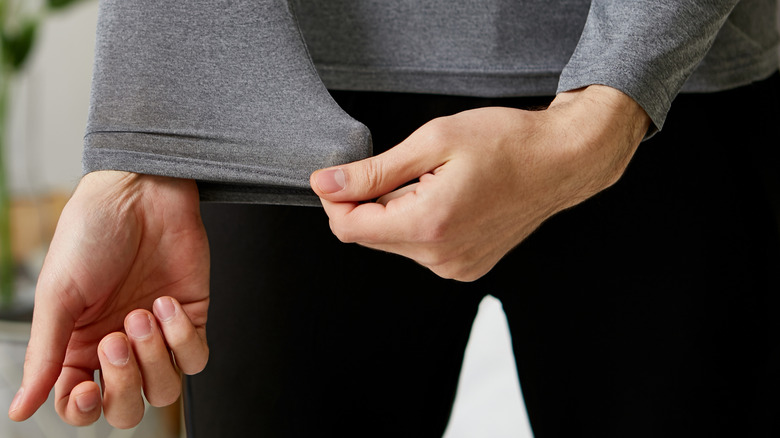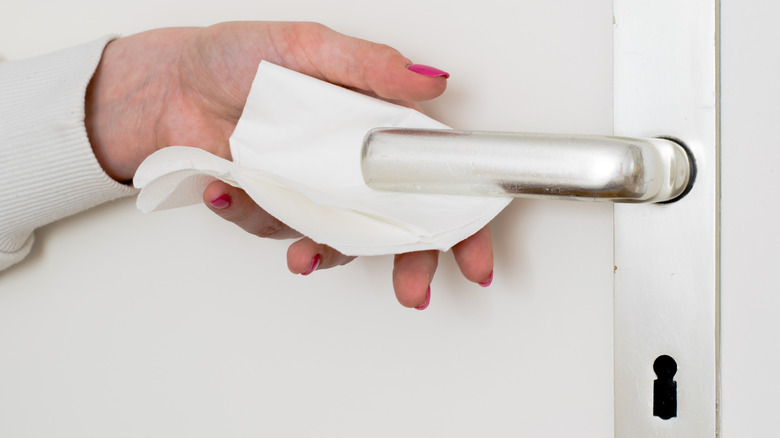Don't Make This Germy Mistake When You Open The Bathroom Door
While some public restrooms may appear clean as a whistle, others can look as if it's been ages since their last deep clean. Sometimes, though, you have to take your chances. In those cases, many people do their best to avoid touching any grimy surfaces as they go.
As it turns out, any public restroom germ concerns are valid. In a 2019 study published in the scientific journal Antimicrobial Resistance & Infection Control, researchers gathered swab samples from 55 public washrooms in China. Specifically, they focused on hand dryers, paper towels, paper towel dispensers, and exit door handles.
The study outcomes revealed that out of more than 200 samples collected, 52 different species of bacteria were detected. Even more, washroom door handles were among the areas found to harbor greater amounts of bacteria. Although most species of bacteria identified did not pose a significant risk to human health, more than 97% of Staphylococcal spp. bacteria samples collected were found to be antibiotic resistant. Additional pathogens — such as E. coli, norovirus, and more — can live on surfaces for anywhere from hours (via Cleveland Clinic) to months.
Don't open a public bathroom door with your shirt sleeve
To avoid direct skin contact with the door handle of a public restroom, you may have tried covering up your hand by pulling down on your shirt sleeve before exiting the bathroom. It's a good idea in theory. After all, your shirt sleeve serves as a protective middleman between your hand and those bathroom-door germs, right? Well, not exactly.
In addition to surviving on surfaces, many types of germs can also live on fabrics. In an early 1982 study published in The Journal of Infectious Diseases, researchers found that the flu virus was able to survive for approximately one to two days on hard surfaces. While its survival window dropped on fabrics, the virus was still able to live anywhere from eight to 12 hours on cloth.
Furthermore, the type of material your shirt is made out of may influence how long pathogens can survive on your sleeve. In a 2020 study published in GMS Hygiene and Infection Control, researchers looked at a variety of pathogens often contracted in healthcare facilities and their survival time on different fabrics. One of these pathogens examined was the norovirus (the common cold) — which was also found on bathroom door handles in the previously mentioned 2019 study. The research findings revealed that the norovirus sustained its infectivity for a week at room temperature on nylon fibers and for up to two weeks on wool.
Open a bathroom door this way instead
Given the amount of time that pathogens can survive on soft materials, that unfortunately gives us a pretty wide window of opportunity to accidentally wipe our nose or face with our sleeve and facilitate the transfer of germs. So what's the most sanitary way to go about opening a restroom door?
Your first thought might be with a tissue or paper towel. However, Bloomberg warns that if you're simply tucking that tissue into your pocket afterward, you've ultimately defeated the purpose. In fact, the 1982 study found that — much like cloth — the flu virus can live on tissues for up to 12 hours. If a trash receptacle is located near the door, you should promptly discard the tissue after pulling on the door handle.
Advances in technology may also be able to help keep public bathroom doors more sanitary. In 2015, Business Insider reported that two adolescents in China had come up with an affordable, self-sanitizing bathroom door handle. Even cooler, it glows (much like a small lightsaber). Using a combination of self-generated UV rays and bacteria-eliminating titanium dioxide, the door handle takes care of germs all on its own.



